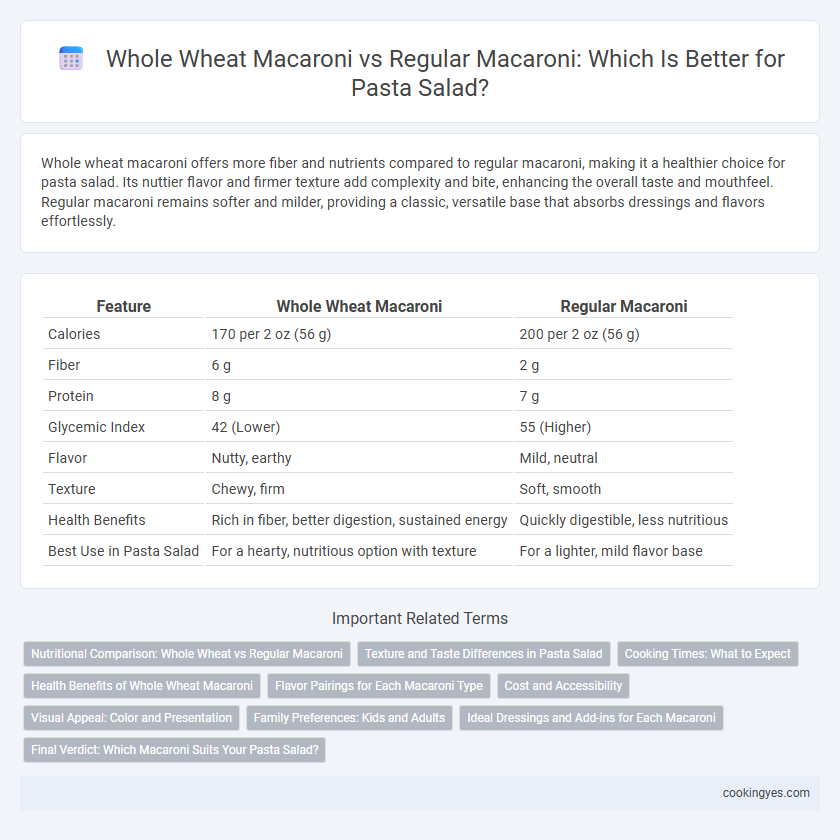Whole wheat macaroni offers more fiber and nutrients compared to regular macaroni, making it a healthier choice for pasta salad. Its nuttier flavor and firmer texture add complexity and bite, enhancing the overall taste and mouthfeel. Regular macaroni remains softer and milder, providing a classic, versatile base that absorbs dressings and flavors effortlessly.
Table of Comparison
| Feature | Whole Wheat Macaroni | Regular Macaroni |
|---|---|---|
| Calories | 170 per 2 oz (56 g) | 200 per 2 oz (56 g) |
| Fiber | 6 g | 2 g |
| Protein | 8 g | 7 g |
| Glycemic Index | 42 (Lower) | 55 (Higher) |
| Flavor | Nutty, earthy | Mild, neutral |
| Texture | Chewy, firm | Soft, smooth |
| Health Benefits | Rich in fiber, better digestion, sustained energy | Quickly digestible, less nutritious |
| Best Use in Pasta Salad | For a hearty, nutritious option with texture | For a lighter, mild flavor base |
Nutritional Comparison: Whole Wheat vs Regular Macaroni
Whole wheat macaroni contains higher amounts of dietary fiber, iron, and B vitamins compared to regular macaroni, supporting improved digestion and sustained energy release. Regular macaroni is typically lower in calories and carbohydrates but lacks the nutritional density found in whole wheat varieties. Choosing whole wheat macaroni for pasta salad enhances nutrient intake, promoting better heart health and glycemic control.
Texture and Taste Differences in Pasta Salad
Whole wheat macaroni offers a denser texture and nuttier flavor compared to regular macaroni, which tends to be softer and milder in taste. In pasta salad, whole wheat macaroni adds a chewy bite that holds dressings well, while regular macaroni creates a creamier, more neutral base that highlights other ingredients. The choice depends on whether you want a heartier texture and robust flavor or a smoother, subtler pasta experience.
Cooking Times: What to Expect
Whole wheat macaroni typically requires a longer cooking time than regular macaroni, averaging 9 to 12 minutes compared to 7 to 9 minutes for regular pasta. The denser texture of whole wheat pasta results from higher fiber content, leading to a chewier bite when cooked al dente. Adjusting cooking times is crucial to achieve the desired tenderness for pasta salad and avoid overcooking or undercooking.
Health Benefits of Whole Wheat Macaroni
Whole wheat macaroni offers higher dietary fiber content compared to regular macaroni, promoting better digestion and prolonged satiety. It also contains more vitamins and minerals, such as iron and magnesium, which support overall health. Incorporating whole wheat macaroni in pasta salad enhances its nutritional profile without compromising taste or texture.
Flavor Pairings for Each Macaroni Type
Whole wheat macaroni offers a nuttier, earthier flavor that pairs exceptionally well with robust ingredients like sun-dried tomatoes, olives, and sharp cheeses such as feta or aged cheddar. Regular macaroni has a milder, more neutral taste, complementing lighter, fresher ingredients like cucumbers, cherry tomatoes, and herbs like basil or dill in pasta salad. Choosing the macaroni type based on flavor intensity enhances the overall balance and appeal of the dish.
Cost and Accessibility
Whole wheat macaroni typically costs 10-20% more than regular macaroni, impacting budget-conscious pasta salad preparations. Regular macaroni is widely available in most grocery stores and supermarkets, while whole wheat varieties may be limited to health food stores or specific sections, affecting accessibility. For large parties or frequent use, regular macaroni offers a more economical and readily available option.
Visual Appeal: Color and Presentation
Whole wheat macaroni offers a rich, nutty brown hue that enhances the visual appeal of pasta salads with a more rustic and wholesome look, contrasting nicely with vibrant vegetables and fresh herbs. Regular macaroni provides a pale yellow color that creates a classic and clean appearance, allowing colorful ingredients like cherry tomatoes and bell peppers to stand out vividly. Choosing whole wheat macaroni can elevate the salad's presentation by introducing earthier tones, while regular macaroni maintains a bright, traditional pasta salad aesthetic.
Family Preferences: Kids and Adults
Whole wheat macaroni offers a nuttier flavor and denser texture that appeals more to health-conscious adults, while regular macaroni's mild taste and soft texture tend to be preferred by kids in pasta salads. Families often balance these preferences by mixing both types or selecting regular macaroni to ensure broader acceptance. Nutritionally, whole wheat macaroni provides higher fiber and essential nutrients, supporting digestive health for growing children and adults alike.
Ideal Dressings and Add-ins for Each Macaroni
Whole wheat macaroni pairs well with robust dressings such as balsamic vinaigrettes or tangy lemon herb sauces, which complement its nutty flavor and hearty texture. Ideal add-ins include roasted vegetables, chickpeas, and aged cheeses like Parmesan to enhance the wholesome profile. Regular macaroni benefits from creamy dressings like ranch or classic Italian, along with mix-ins such as diced bell peppers, olives, and shredded mozzarella for a milder, more traditional pasta salad.
Final Verdict: Which Macaroni Suits Your Pasta Salad?
Whole wheat macaroni offers higher fiber and nutrient content, enhancing the nutritional value of pasta salads with a nuttier flavor and firmer texture. Regular macaroni provides a softer bite and milder taste, ideal for traditional, creamy pasta salads. Choose whole wheat macaroni for health-conscious recipes and regular macaroni for classic, crowd-pleasing pasta salads.
Whole wheat macaroni vs Regular macaroni for pasta salad Infographic

 cookingyes.com
cookingyes.com